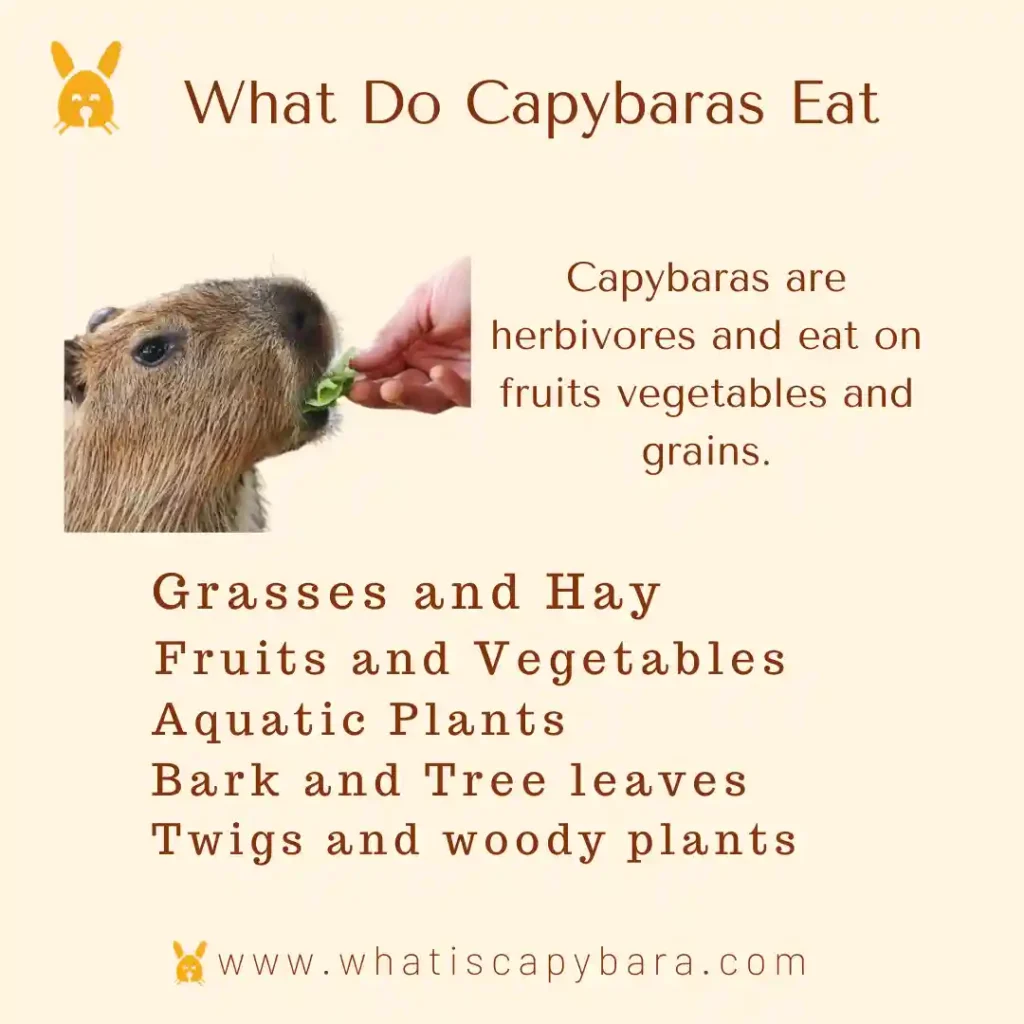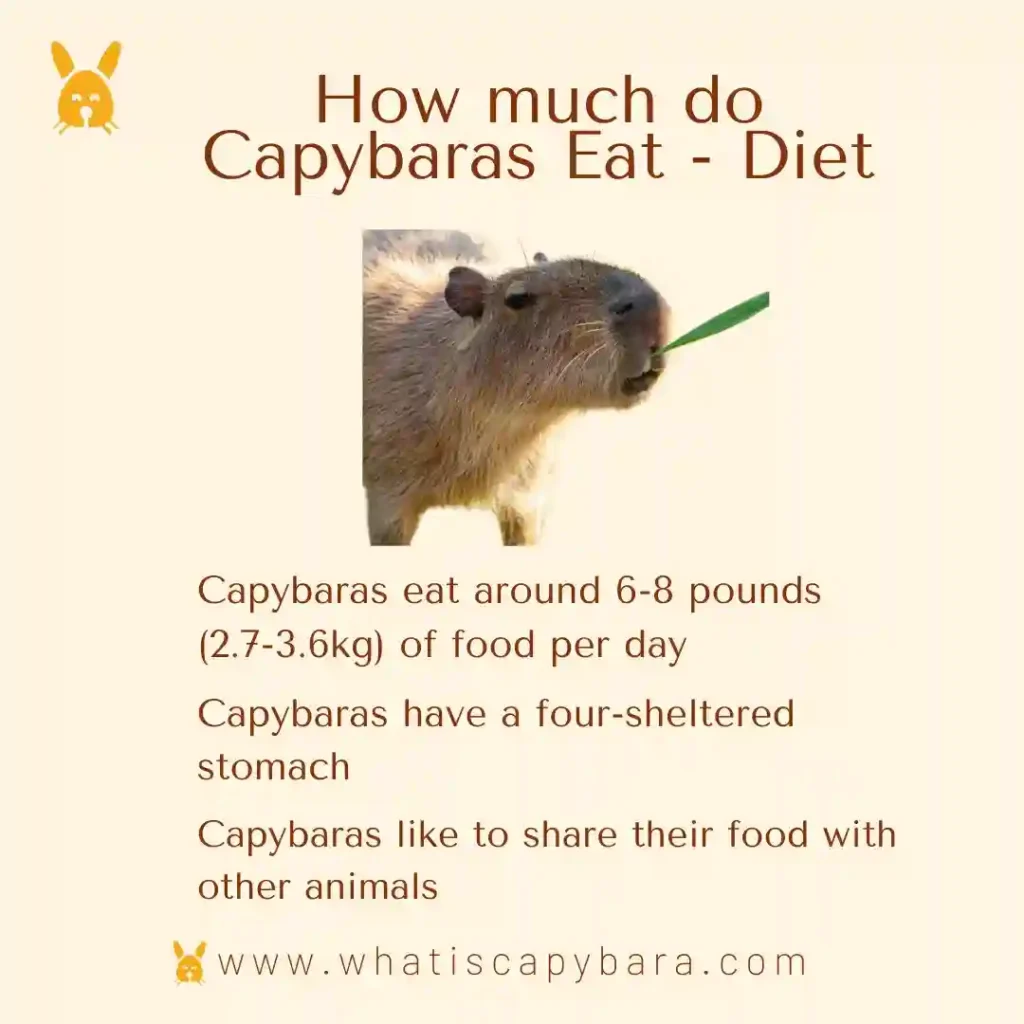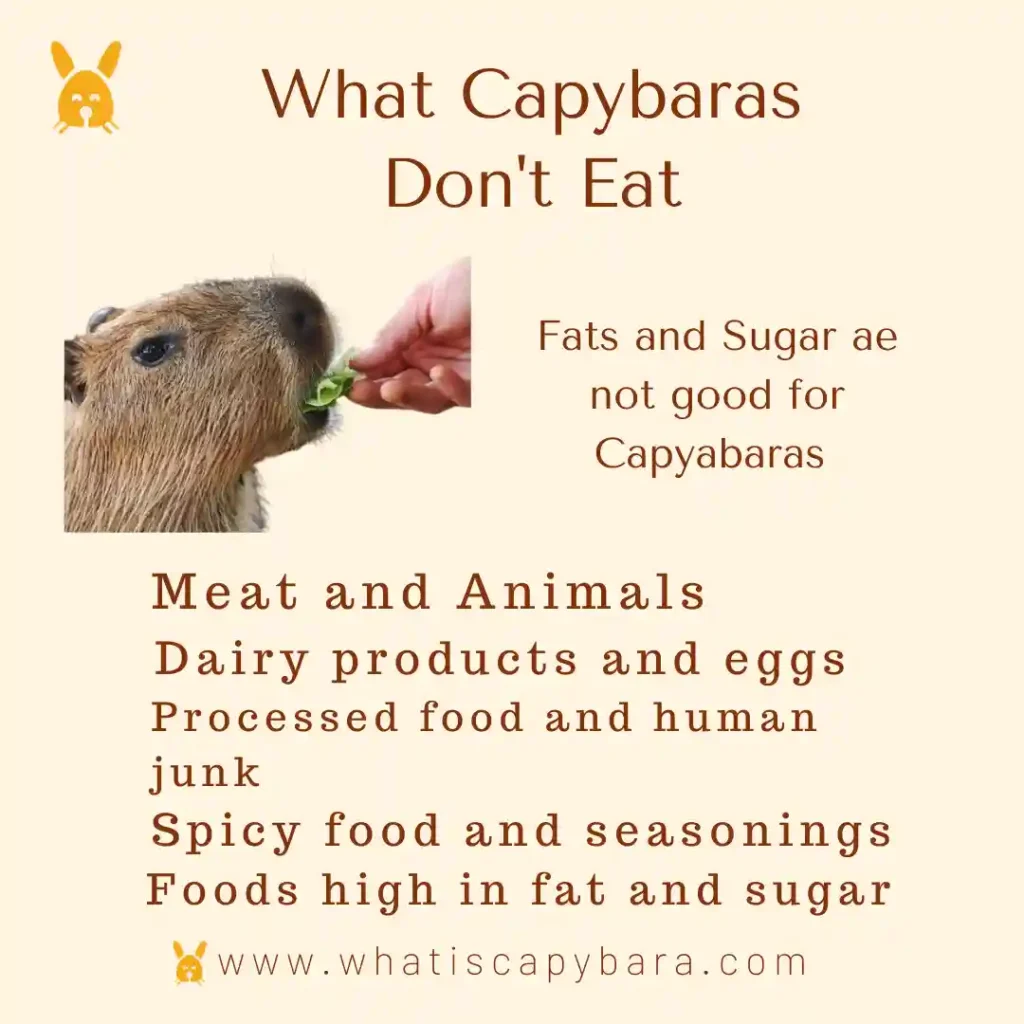Capybaras are herbivorous, and survive on plants and fruits. In this composition, we will explore what do capybaras eat, capybaras diet and how their diet contributes to their life and survival.
We’ll cover topics similar to what do capybaras eat, what they shouldn’t eat, capybara diet, nutritional requirements of capybaras, etc.
We’ll also claw into other aspects of capybara biology, similar to capybara size and capybara weight, capybara lifespan, and unique feeding behavior. With this information, we can gain a deeper understanding of these amazing creatures and work toward their conservation and protection.
Contents
- 1 What Do Capybaras Eat – Capybara Diet
- 2 What Plants Do Capybaras Eat
- 3 What Fruits Do Capybaras Eat
- 4 How Much Do Capybaras Eat
- 5 Nutritional Requirements of Capybaras
- 6 What Do Capybaras Shouldn’t Eat
- 7 Capybara Food Chain
- 8 How Much Does a Capybara Weigh?
- 9 Capybara Appearance
- 10 How Do Capybaras Obtain their Water?
- 11 Capybara Lifespan
- 12 What Do Capybaras Do for the Environment
- 13 Capybara Facts
- 14 To Wrap Up
What Do Capybaras Eat – Capybara Diet
Capybaras are the biggest rodents and need a good diet to be healthy as they are also herbivores but in actual what do capybaras eat is what we are going to tell.
Capybaras have a diet that substantially consists of grasses, aquatic shops, and fruits. They also feed on tree bark, leaves, and vegetables.
According to a research journal Mammalia, more than 70 % of capybara’s diet comes from 4 food items, sedges (Cyperaceae), switchgrass (Panicum grumosum), Bermuda grass (Cynodon), and crowngrass (Paspalum).
Table showing what do capybaras eat and What capybaras don’t eat:
| What Do Capybaras Eat | What Capybaras Don’t Eat |
| Grasses and hay | Meat and animal products |
| Fruits and vegetables | Dairy products and eggs |
| Aquatic plants | Processed foods and human junk |
| Bark and tree leaves | Spicy foods and seasonings |
| Twigs and woody plants | Foods high in fat and sugar |
It’s important to note that capybaras are wild creatures and shouldn’t be fed by humans. Feeding them unhealthy or dangerous foods can lead to health problems and behavioral issues.
It’s important to admire their natural diet and habitat and to take measures to promote their conservation in the wild.

What Plants Do Capybaras Eat
What do capybaras eat among all the plants? Plants that capybaras eat are:
- Fresh Grasses
- Barks
- Tubers
- Sugar Cane
- Sweet potatoes
- Plant Roots
- Lettuce
- Green beans
- Spinach
- Broccoli
- Cabbage
This list is not yet over. Read What plant do capybaras eat. But make sure it should not contain fat and sugar in good amount.
What Fruits Do Capybaras Eat
What do capybaras eat among all the fruits? Capybaras mostly eat all the fruits, but fruits that they most like are:
- Melons
- Oranges
- Watermelons
- Squash
- Strawberries
- Raspberries
- Blueberries
- Blackberries
and all other fruits as well. But it should not be given much as they struggle digesting fat and sugar.
How Much Do Capybaras Eat
- Capybaras have a large appetite, and they can consume up to 6- 8 pounds(2.7-3.6 kg) of food per day. They have got a unique digestive system that allows them to digest tough factory material.
- Capybaras have a four-sheltered stomach, which is analogous to that of a cow, enabling them to break down cellulose, a tough material set up in shops.
- In terms of feeding behavior, capybaras are social creatures and generally feed together in groups of 10- 20 individuals. This behavior allows them to find further food and protects bloodsuckers.
- Capybaras are also known for their friendly nature and frequently share their food with other creatures, similar to birds.

Nutritional Requirements of Capybaras
Their nutritive conditions are based on their feeding behavior, digestive system, and overall physiology. Every being required fiber, protein and other nutrition.
Being herbivorous, what do capybaras eat to meet all the nutritional requirements.
- Fiber: Capybaras need a diet high in fiber to support their digestive system.
- The fiber helps to break down the tough plant material that they eat and provides a source of energy.
- A diet high in fiber also helps to maintain the overall health of the digestive system.
- Carbohydrates: Capybaras bear a source of carbohydrates to give energy for their diurnal activities.
- They gain carbohydrates from the plant-grounded materials they eat, similar to grasses, fruits, and vegetables.
- Protein: Capybaras need a source of protein in their diet to support growth and tissue form.
- Protein is also necessary for the production of enzymes, hormones, and other essential molecules.
- Vitamins and minerals: Capybaras bear a range of vitamins and minerals to support their overall health.
- These include vitamin A, vitamin C, vitamin D, calcium, and phosphorus.
- Water: Capybaras bear access to clean drinking water, as they need to drink water regularly to maintain their hydration situations.
What Do Capybaras Eat – Nutritional Requirements
| Nutrient | Requirement |
| Water | Capybaras require roughly 1- 2 liters of water per day. This may vary depending on factors similar as their diet, activity level, and environmental conditions. |
| Protein | Capybaras bear a moderate amount of protein in their diet, as they’re beasties and calculate on plant- based sources for their nutrition. Their protein conditions can be met by consuming a variety of plant materials, similar as grasses, leaves, and vegetables. |
| Food | Capybaras consume up to 8 pounds(3.6 kg) of food per day, which consists substantially of grasses, submarine shops, fruits, and vegetables. They also bear a small amount of fat in their diet for energy and to support their metabolic processes. |
What Do Capybaras Shouldn’t Eat
We have already covered what do capybaras eat but there are food that they shouldn’t eat for a healthy life. It’s important to note that capybaras have a unique digestive system that allows them to break down tough factory material.
Still, they’re susceptible to digestive problems if they consume food that’s too high in fat or sugar.
It’s important to give them a well-balanced diet that meets their nutritive requirements and avoid giving them food that’s dangerous to their health.

Capybara Food Chain
Capybara food chain is quite simple. Capybaras are primary consumers in the food chain. They eat on producers such as plants and fruits as they are herbivorous.
They are hunted by secondary and tertiary predators such as anacondas, jaguars, caimans and eagles
How Much Does a Capybara Weigh?
Capybaras are the largest rodents in the world, and they can weigh up to 140 pounds( 64 kg). The weight of a capybara can vary depending on factors similar to age, relations, and niche.
Adult capybaras are generally larger than females, and capybaras that live in areas with abundant food and water coffers are likely to be heavier than those in less favorable conditions.
They’ve got a complex digestive system, which includes a four-sheltered stomach that allows them to break down the tough plant material they eat.
Capybara Appearance
Capybaras have sturdy and muscular bodies that are acclimated to their semi-aquatic life. They’ve short and heavyset legs, a broad and flat head, and a thick fleece of fur that provides sequestration and protection from the rudiments.
Capybaras also have a unique digestive system that helps them prize nutrients from the tough factory material that they eat.
They’re excellent swimmers and can spend hours in the water, using their important legs to navigate through the water and their webbed feet to swim efficiently.
The weight of a capybara is an important aspect of its biology and ecology. Capybaras are beasties and bear a significant quantum of food to maintain their body weight and energy situations.
How Do Capybaras Obtain their Water?
Capybaras gain the utmost of their water from the plants they eat, especially those that grow in or near water. These shops are high in humidity content, and as capybaras graze, they take in the water that’s available in the plants.
In addition, capybaras are semi-aquatic creatures and are known to spend a lot of time in or near water bodies, similar to rivers, ponds, and wetlands.
Capybaras have a unique adaption that allows them to retain water efficiently.
During the digestion process, capybaras can prize and retain water from the food they consume, allowing them to maintain their hydration situations indeed in dry surroundings.
In addition to the water attained from the plants they eat, capybaras also drink water directly from the water bodies they inhabit.
Capybaras are also known to submerge themselves in the water to escape from bloodsuckers and regulate their body temperature.
They also have a unique behavior where they defecate in the water, which provides a source of nutrients for other submarine organisms and helps to maintain the balance of the ecosystem.
Capybara Lifespan
Capybaras have a lifetime of 8- 10 years in the wild, but they can live up to 12 years in captivity. Their lifetime is affected by colorful factors, including niche destruction, hunting, and disease.
Capybaras aren’t considered endangered, but their population is dwindling in some areas due to habitat loss.
What Do Capybaras Do for the Environment
Capybaras are fascinating creatures that play an important part in their ecosystem. As the largest rodents in the world, they’ve got a significant impact on the vegetation and other creatures in their habitat.
By understanding what capybaras eat and their salutary requirements, we can appreciate and cover these unique creatures.
Capybara Facts
Capybaras are fascinating creatures, and there are numerous intriguing facts about them. Here’s below:
- Capybaras are the largest rodents in the world, importing up to 140 pounds( 64 kg) and measuring over four bases(1.2 measures) in length.
- Capybaras are semi-aquatic and are excellent swimmers. They can hold their breath for over five minutes aquatic and can swim at pets of over 22 miles( 35 kilometers) per hour.
- Capybaras are social creatures and live in groups of over 20 individuals. They use a variety of declamations, similar to barks, whistles, and grunts, to communicate with each other.
- Capybaras have a unique digestive system that allows them to break down tough plant material efficiently. They’ve got a four-sheltered stomach and a technical cecum that helps them prize nutrients from the plants they eat.
- Capybaras have webbed bases, which help them swim efficiently and navigate through the water. Their bases also have scent glands that they use to mark their home.
- Capybaras are herbivores and have a diet that substantially consists of grasses, fruits, and vegetables. They can eat up to eight pounds(3.6 kg) of food per day.
- Capybaras are native to South America, where they’re set up in a range of territories, including leas, forests, and wetlands.
- Capybaras have an amenable temperament and are frequently kept as pets in some parts of the world. still, they’re wild creatures and bear technical care and suitable living terrain.
- Capybaras have a long lifetime, with some individualities living up to 8- 10 times in the wild and over to 12 times in captivity.
- Capybaras have a unique behavior where they roll in the slush to cool themselves off and to cover their skin from sponges and insects. This behavior is known as” wallowing” and is common in numerous other species of creatures.
What do capybaras eat in rainforest
Capybaras mostly eat fresh grass. An adult capybara eat 6-8 lbs a day.
To Wrap Up
In conclusion, capybaras are fascinating creatures with numerous unique characteristics and actions. Their large size, social behavior, and swimming capability make them one of the most intriguing creatures in the world.
Understanding further about capybaras can help us appreciate their ecological and artistic significance and promote their conservation in the wild. Capybaras are quotidian creatures, which means they’re active during the day and sleep at night.
They generally feed early in the morning or late in the autumn, taking advantage of the cooler temperatures. During the day, capybaras generally rest or spend time in the water to cool off.
Read more :
Capybara as pets – do capybaras make good pets

